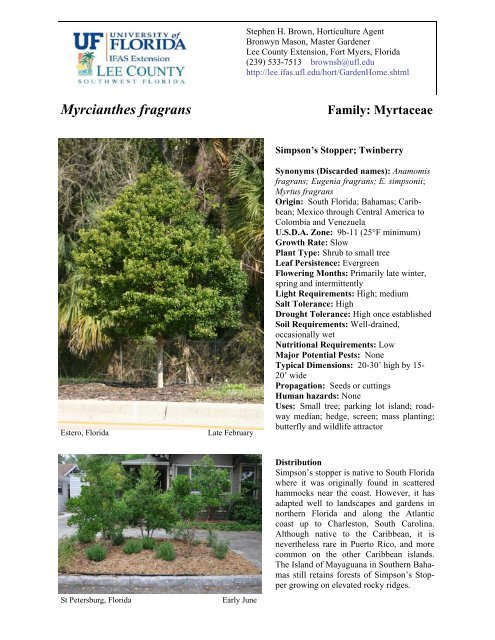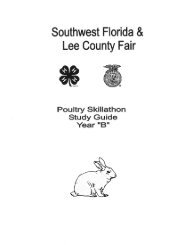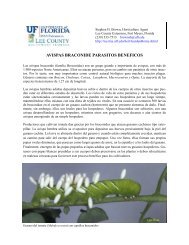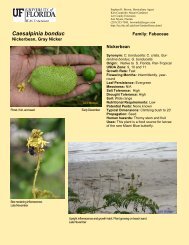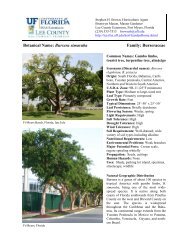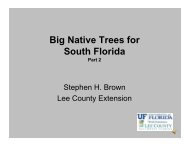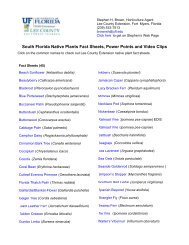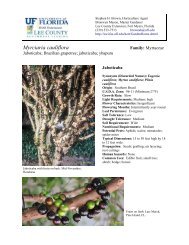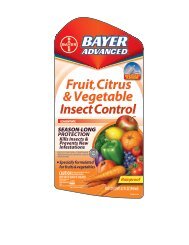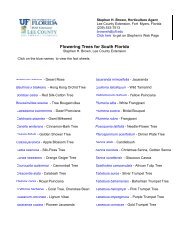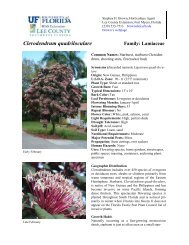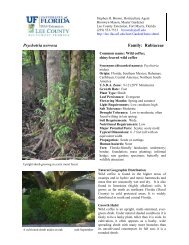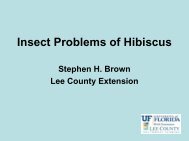Myrcianthes Fragrans Family: Myrtaceae - Lee County Extension ...
Myrcianthes Fragrans Family: Myrtaceae - Lee County Extension ...
Myrcianthes Fragrans Family: Myrtaceae - Lee County Extension ...
Create successful ePaper yourself
Turn your PDF publications into a flip-book with our unique Google optimized e-Paper software.
<strong>Myrcianthes</strong> fragrans <strong>Family</strong>: <strong>Myrtaceae</strong><br />
Estero, Florida Late February<br />
St Petersburg, Florida Early June<br />
Stephen H. Brown, Horticulture Agent<br />
Bronwyn Mason, Master Gardener<br />
<strong>Lee</strong> <strong>County</strong> <strong>Extension</strong>, Fort Myers, Florida<br />
(239) 533-7513 brownsh@ufl.edu<br />
http://lee.ifas.ufl.edu/hort/GardenHome.shtml<br />
Simpson’s Stopper; Twinberry<br />
Synonyms (Discarded names): Anamomis<br />
fragrans; Eugenia fragrans; E. simpsonii;<br />
Myrtus fragrans<br />
Origin: South Florida; Bahamas; Caribbean;<br />
Mexico through Central America to<br />
Colombia and Venezuela<br />
U.S.D.A. Zone: 9b-11 (25°F minimum)<br />
Growth Rate: Slow<br />
Plant Type: Shrub to small tree<br />
Leaf Persistence: Evergreen<br />
Flowering Months: Primarily late winter,<br />
spring and intermittently<br />
Light Requirements: High; medium<br />
Salt Tolerance: High<br />
Drought Tolerance: High once established<br />
Soil Requirements: Well-drained,<br />
occasionally wet<br />
Nutritional Requirements: Low<br />
Major Potential Pests: None<br />
Typical Dimensions: 20-30’ high by 15-<br />
20’ wide<br />
Propagation: Seeds or cuttings<br />
Human hazards: None<br />
Uses: Small tree; parking lot island; roadway<br />
median; hedge, screen; mass planting;<br />
butterfly and wildlife attractor<br />
Distribution<br />
Simpson’s stopper is native to South Florida<br />
where it was originally found in scattered<br />
hammocks near the coast. However, it has<br />
adapted well to landscapes and gardens in<br />
northern Florida and along the Atlantic<br />
coast up to Charleston, South Carolina.<br />
Although native to the Caribbean, it is<br />
nevertheless rare in Puerto Rico, and more<br />
common on the other Caribbean islands.<br />
The Island of Mayaguana in Southern Bahamas<br />
still retains forests of Simpson’s Stopper<br />
growing on elevated rocky ridges.
Growth Habit<br />
Simpson’s stopper is a multi-stemmed shrub or small tree with a densely branched and densely leafy<br />
evergreen crown. The crown varies from narrow and subcolumnar to wider than the plant is tall. It is<br />
distinguished by a trunk with flaking outer bark, a reddish brown inner bark, and a smooth mottled tangray<br />
trunk after bark exfoliation. The exfoliated bark is somewhat like the introduced guava, Psidium<br />
guajava. The tree will typically grow to about 25 feet in Florida and develops a buttressed base with age.<br />
Cultivars<br />
Seedling form Simpson’s stopper can be selected fro a range of features including reddish new foliate,<br />
smaller leaves, better form, and compact shape. The ‘Compacta’ form is a lower growing shrub to 5 feet<br />
and can be used in smaller landscape setting or as foundation plants.<br />
Flaking outer bark Buttressed base<br />
Leaves<br />
The leaves are simple, entire and opposite with a short petiole. The blade is elliptic to obovate, thick and<br />
leathery and between 1 to 2 inches long and 0.5 to 1.25 inches wide. The upper surface is shiny green,<br />
and the lower surface is dull light green. New leaves may range in color from pale chartreuse to deep<br />
wine red. The blade may curl under at the margins and the apex is either blunt or rounded and sometimes<br />
notched. It is covered with tiny gland dots that emit a pleasant fragrance when crushed. The side<br />
veins are inconspicuous.<br />
Flower and Fruit<br />
Simpson’s stopper flowers in light to heavy flushes throughout the year. The heaviest bloom however<br />
begins in February, spring, or early summer. The flowers are fragrant, small, showy, pure white, and<br />
clustered in cymes. There are 4 concave white petals and many white spreading stamens giving the<br />
plant a fuzzy appearance when in bloom. Heavy flowering is followed by fruiting. The fruit is a red<br />
berry, 2-seeded, and approximately 1/3 inches round. The fruit is borne singly but more often in clusters<br />
of 2-4 and is edible. Blue jays, cardinals and the mockingbirds, the state bird of Florida, feed on the<br />
fruit. The plant’s dense canopy also provides shelter for the birds. Butterflies as well as bees are also<br />
attracted to Simpson’s stopper.
Leaves Mid-March<br />
Flowers Late-February<br />
Unripe fruits Early March<br />
Leaves and newly formed flower buds Mid-April<br />
Flowers Late-April<br />
Fruits Early March
Uses<br />
Simpson’s stopper is commonly used as a hedge, specimen or tree. It is It is tolerant of highly alkaline<br />
calcareous soils. Thus it is well adapted for South Florida parking lots, and landscapes composed of<br />
filled soils mined from calcareous rocks well below the soil’s surface. Florida Department of Transportation<br />
has approved Simpson’s stopper as a frangible tree. This provide many more opportunities to use<br />
Simpson’s stopper on roadway landscape projects. It is especially useful in the narrow center medians<br />
where only frangible trees and plants are allowed.<br />
Roadway tree in bloom Late April<br />
Rick Joyce<br />
Rick Joyce<br />
Ripe fruits Mid July Ripe fruits Mid July<br />
Leu Garden, Orlando Late April
Planting and Maintenance Guidelines<br />
In South Florida, Simpson’s stopper can be planted year-round. It is a slow grower. It grows to about 25<br />
feet tall but only at a rate of 6 inches to a foot per year. The plant will tolerate alkaline and wet soils but<br />
it is also drought tolerant. However, within the first 4 years after planting, the tree may show signs of<br />
drought stress during extended dry periods. Thus, it should be sufficiently irrigated during the dry seasons<br />
of its early years. Once established, it requires little or no irrigation. Simpson’s stopper will grow<br />
well in either sun or medium shade. It grows densely in full sun and is taller on a more loosely<br />
branched when grown in shade. It has a high salt tolerance, and is hardy to about 25°F. It has survived<br />
17°F with very little tip burn. Simpson’s stopper shears well. It tolerates severe shearing making it suitable<br />
for use as a hedge, bonsai, topiary or grown on the patio in a large container. To develop a hedge,<br />
space plants 36-60 inches apart. When used as a hedge, flowering and fruiting may be curtailed if it is<br />
trimmed too frequently. Simpson’s stopper is an evergreen and is not messy in the landscape.<br />
Hedge Mid-January<br />
Pests<br />
Guava rust disease (Puccinia psidii) is an ornamental plant disease which attacks stressed Simpson’s<br />
stopper plants. Usually fungus is associated with wet conditions, but guava rust will thrive in South Florida’s<br />
cool winter periods where there is little rainfall. The fungus is evident by the rusty spores on new<br />
growth and young leaves. It causes dieback. The disease is rarely encountered on Simpson’s stopper but<br />
is more prevalent on Eugenia. A fungicide labeled for this disease on ornamentals may be applied. Once<br />
the heat of summer arrives, the pathogen becomes less active.<br />
Light guava rust infection Late February<br />
Doug Caldwell<br />
Heavy guava rust infection Late February
References<br />
Gilman, Edward. Revised 2011. Mycrianthes fragrans Simpson’s stopper, Twinberry. UFIFAS, EDIS<br />
publication #FPS418, University of Florida, Gainesville, FL http://edis.ifas.ufl.edu/fp418<br />
Haehle, RG, Brookwell, J. R. 2004. Native Florida Plants. Taylor Trade Publishing, Lanham, MD<br />
Little, Elbert, Jr., Woodbury, Roy, O. and Wadsworth, Frank, H. 1974.. Trees of Puerto Rico and the<br />
Virgin Islands. U.S. Government Printing Office, U.S. Department of Agriculture, Washington, D.C.<br />
Nelson, Gil. 2003. Florida’s Best Native Landscape Plants: 200 readily available species for homeowners<br />
and professionals. University Press of Florida, Gainesville, FL<br />
Osorio, Rufino. 2001. A Gardener’s Guide to Florida’s Native Plants. University Press of Florida,<br />
Gainesville, FL<br />
Tomlinson, P.B. 1980. The Biology of Trees Native to Tropical Florida. Harvard University Printing<br />
Office, Allston, MA<br />
Useful Links<br />
South Florida Native Plant Fact Sheets<br />
Native Plants for Home Landscapes<br />
Florida Native Landscaping<br />
Ornamental Trees for South Florida<br />
Small Trees for South Florida<br />
‘Shady Lady’ Black Olive<br />
FYN Publications<br />
This fact sheet was reviewed by Sandra Barbour Wilson, UF Indian River Research and Education Center,<br />
Fort Pierce, Florida; John Sibley, <strong>Lee</strong> <strong>County</strong> Master Gardener and owner of All Native Garden<br />
Center, Nursery & Landscapes, Fort Myers, Florida; ; Rick Joyce, Forestry Resources Ecological, Inc.,<br />
Fort Myers, Florida; Jenny Evans, Sanibel Captiva Foundation, Sanibel, Florida; Peggy Cruz,<br />
<strong>Lee</strong> <strong>County</strong> <strong>Extension</strong> Service; Cathy Feser, Naples, Florida.<br />
The Institute of Food and Agricultural Sciences (IFAS) is an Equal Opportunity Institution authorized to provide research, educational information<br />
and other services only to individuals and institutions that function with non-discrimination with respect to race, religion, age, disability,<br />
sex, sexual orientation, martial status, national origin, political opinions or affiliations. U.S. Department of Agriculture, Cooperative <strong>Extension</strong><br />
Service, University of Florida, IFAS, Florida A. & M. 2/2012.


